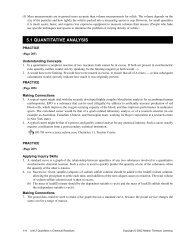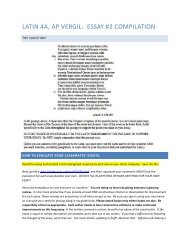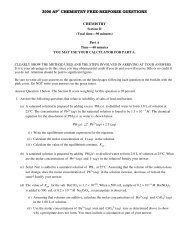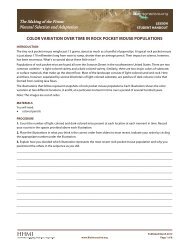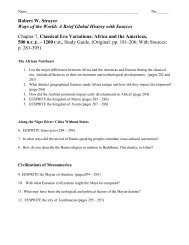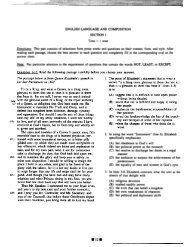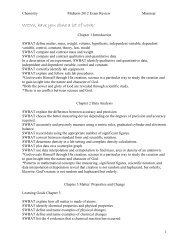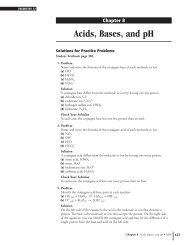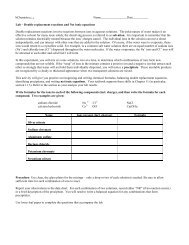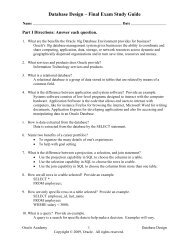Chapter 17 Study Guide - Quia
Chapter 17 Study Guide - Quia
Chapter 17 Study Guide - Quia
You also want an ePaper? Increase the reach of your titles
YUMPU automatically turns print PDFs into web optimized ePapers that Google loves.
Name____________________________________________________________<br />
Per.______<br />
Robert W. Strayer - Ways of the World: A Brief Global History with Sources<br />
<strong>Chapter</strong> <strong>17</strong> <strong>Study</strong> <strong>Guide</strong>:<br />
Atlantic Revolutions and Their Echoes, <strong>17</strong>50-1914 (pp. 771-805)<br />
Comparing Atlantic Revolutions<br />
1. In what ways did the ideas, and heart, of the Enlightenment contribute to the Atlantic<br />
Revolutions? List the old, conventional ideas and the new Enlightenment ideas that challenged<br />
them.<br />
2. Explain similarities and differences between the Atlantic revolutions. (page 781)<br />
American Revolution <strong>17</strong>75 - <strong>17</strong>87:<br />
3. What was revolutionary about the American Revolution and what was not, in its break with<br />
Britain? 782<br />
4. Where did the political authority remain after America’s independence from Britain? 783<br />
French Revolution <strong>17</strong>89 – 1815 (Includes the rule of Napoleon <strong>17</strong>99 – 1815):<br />
5. Describe the composition of the three estates in France. (p. 784)<br />
6. How did the French Revolution differ from the American Revolution? (find the 4 differences)<br />
pp. 785-786<br />
7. What French Revolution elements were spread throughout Europe by the conquests of<br />
Napoleon? 787<br />
8. What revolutionary practices were imposed throughout Europe by Napoleon? 787<br />
Haitian Revolution <strong>17</strong>91 - 1804:<br />
9. While the Haitian Revolution had been the only successful slave revolt in history, what were<br />
the social, political, and economic outcomes of it? 789<br />
Latin American Revolutions 1810 - 1825:<br />
10. Despite the creole elites’ disenchantment with Spanish rule, what events in Europe instigated<br />
independence movements in Latin America (include the movements of Fathers Hidalgo and<br />
Jose Morelos, and Simon Bolivar and Jose San Martin)? 791 - 792<br />
11. How did the United States and Latin America develop differently after their independence? 793<br />
Abolition of Slavery:<br />
12. What were the years of the abolitionist movement? 793<br />
13. List ideological, religious, economic and political factors that contributed to the end of slavery.<br />
794<br />
14. How did the end of slavery in the U.S. affect the lives of the former slaves? 795<br />
15. Compare the southern United States period of radical reconstruction with that of Russia’s<br />
ending of serfdom. 795<br />
Nationalism<br />
16. How did Napoleon, through its conquest of Europe, inadvertently spread nationalism<br />
throughout Europe? 796<br />
<strong>17</strong>. List the impact of nationalism on: 797 - 798<br />
a. Germany and<br />
Italy<br />
b. Greeks and<br />
Serbs<br />
c. Czechs and<br />
Hungarians<br />
d. Poles and<br />
Ukrainians<br />
e. The Irish<br />
f. European<br />
Jews<br />
g. Egypt<br />
18. What were the achievements and limitations of nineteenth century feminism? 801<br />
h. Japan<br />
i. India<br />
j. Ottoman<br />
Empire<br />
k. China
________1. The chief beneficiaries of all but one of the Atlantic revolutions were<br />
(A) propertied white men of the “middling classes.”<br />
(B) upper class, aristocratic women.<br />
(C) lower class white men who did not own property.<br />
(D) slaves and indentured servants.<br />
________2. A distinguishing characteristic of the French Revolution when compared to the<br />
American Revolution was that the French Revolution<br />
(A) drew on Enlightenment ideas about liberty.<br />
(B) sought to recreate society from scratch.<br />
(C) sought to preserve existing liberties rather than to establish new ones.<br />
(D) maintained the monarchy, whereas the Americans broke with this form of government.<br />
________3. Which of the following was an outcome of the American Revolution?<br />
(A) Political authority no longer resided in the hands of pre-Revolutionary colonial elites.<br />
(B) Enlightenment ideals were increasingly rejected as part of a quest for stability.<br />
(C) It established nearly universal voting rights in the former colonies.<br />
(D) It accelerated the established democratic tendencies of the colonial societies.<br />
________4. What was the most distinctive feature of the Haitian Revolution?<br />
(A) Its status as the only completely successful slave revolt in world history.<br />
(B) The success of different races at putting aside differences in the name of the revolution.<br />
(C) Its failure to influence the populations of other Caribbean islands.<br />
(D) Its relative lack of violence.<br />
________5. What best describes the result of Napoleon’s conquest and reform of European lands<br />
outside France?<br />
(A) The conquered were grateful to Napoleon.<br />
(B) The conquered accepted many of the reforms, but revolted against French control.<br />
(C) The conquered refused to accept the reforms and fought bitterly against French control.<br />
(D) The conquered refused to accept the reforms, but passively accepted French control.<br />
________6. Which of the following was an impact of the Haitian Revolution throughout the Atlantic<br />
world?<br />
(A) Napoleon bought the Louisiana territory from the United States.<br />
(B) The movement to abolish slavery collapsed as fear of free slaves grew.<br />
(C) Slave owners and whites were filled with fear and trepidation.<br />
(D) Similar slave insurrections spread throughout the Atlantic world, including Brazil,<br />
Jamaica, and Louisiana.<br />
________7. Which of the following is one reason why the Spanish American revolutions took longer<br />
and were more difficult than the (North) American Revolution?<br />
(A) Language barriers in Spanish America<br />
(B) Greater wealth in Spain than in Britain<br />
(C) Divisions of class, race, and region within Spanish America<br />
(D) Stability of the royal government in Spain<br />
________8. What great fear drove the Latin American creole elites to pursue independence and<br />
political change?<br />
(A) They feared falling behind the United States economically and politically.<br />
(B) They feared that the Church was gaining too much power over them.<br />
(C) They feared that social unrest from the lower classes and nonwhites would get out of<br />
control.<br />
(D) They feared the Spanish and Portuguese monarchies were going to replace them with<br />
new elites drawn from the lower classes.<br />
________9. Which of the following arguments made the cause of abolition widely acceptable in the<br />
nineteenth century?<br />
(A) Slavery was immoral.<br />
(B) Slavery was not condoned in the Bible.<br />
(C) Slavery benefited Portuguese slave traders too much.<br />
(D) Slavery was no longer necessary for economic progress.<br />
________10. Which of the following is true of the women’s movement by the early 1900s?<br />
(A) It had secured widespread voting rights for women across Europe.<br />
(B) In the most industrialized countries of the West, it had become a mass movement.<br />
(C)<br />
(D)<br />
Large numbers of working-class women had gained entrance to universities.<br />
While a number of nations had strong feminist movements, there was little or no contact<br />
between them.




